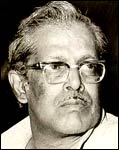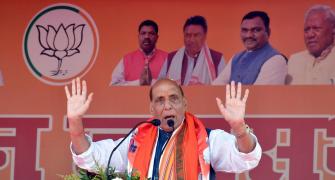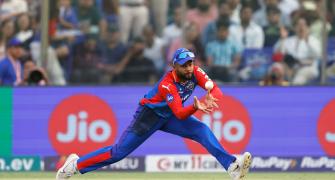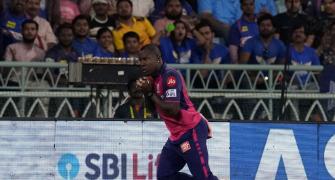It may have the makings of a classic. A cult subject. An ensemble cast. Superior technical quality and inspired direction. Yet, sometimes, a film fails to receive the recognition it deserves for inexplicable reasons.
Hrishikesh Mukherjee's Musafir is one such film.  Musafir opens with Balraj Sahni's voiceover and the camera shifting to a scruffy blockhouse: "Lakh lakh makaan aur inmein rehnewale karodon insaan. In karodon insaan ke sukh dukh, hasne rone ke maun darshak hain yeh maun makaan. Theek musafiron ki tarah yahan log aatein hai, rehte hain aur chale jaatein hain. Yahin janam hota hai, vivah hota hai aur hoti hai mrityu. Musafir teen kirayedaron ke jeevan chakron ki kahani hai jo ek ke baad ek is makaan mein rehne aate hain [Scores of people live inside these houses. They are mute spectators to the ups and downs of their lives. People come here like travellers and leave. Some are born here. Some get married here. And some die here. Musafir is the story of three such tenants who came to live in this house]."
Musafir opens with Balraj Sahni's voiceover and the camera shifting to a scruffy blockhouse: "Lakh lakh makaan aur inmein rehnewale karodon insaan. In karodon insaan ke sukh dukh, hasne rone ke maun darshak hain yeh maun makaan. Theek musafiron ki tarah yahan log aatein hai, rehte hain aur chale jaatein hain. Yahin janam hota hai, vivah hota hai aur hoti hai mrityu. Musafir teen kirayedaron ke jeevan chakron ki kahani hai jo ek ke baad ek is makaan mein rehne aate hain [Scores of people live inside these houses. They are mute spectators to the ups and downs of their lives. People come here like travellers and leave. Some are born here. Some get married here. And some die here. Musafir is the story of three such tenants who came to live in this house]."
Story # 1: A young unmarried couple elopes and rents this house. Their conversation reveals that the girl's uncle was planning to marry her off to an old man. The two marry the next day and begin their new life. But both Ajay (Shekhar) and Shakuntala (Suchitra Sen) wish to be accepted by the former's parents who are against this union. One day, Ajay's parents (Bipin Gupta, Durga Khote) come to the house to disown him. To their surprise, Shakuntala turns out to be an ideal daughter-in-law. All's well that ends well.
Story # 2: An old man (Nazir Hussain) arrives with his widowed pregnant daughter-in-law (Nirupa Roy) and youngest son, Bhanu (Kishore Kumar). The old man is struggling to make ends meet, having just lost his eldest son. All hopes are set on Bhanu. Bad luck continues as Bhanu fails to find employment. In a fit of frustration, Bhanu consumes poison. The next morning when he wakes up, he is alive and kicking. The poison was adulterated. More good news follows: he has a job and his Bhabhi delivers a baby boy.
Story # 3: The third tenant is a crabby barrister (Paul Mahendra), his widowed sister Uma (Usha Kiron) and her handicapped little boy (Daisy Irani). In the previous two episodes, the mention of a mysterious violin player keeps coming up. Here, his identity is finally revealed. Pagla Babu, as the nearby tea vendor calls him, is a homeless wanderer who plays the violin for his own satisfaction. Pagla Babu aka Raja (Dilip Kumar) turns out to be Uma's ex-flame. Raja is dying of a fatal disease but he gives hope to Uma's son, also named Raja. He promises that the day a red flower blooms outside his window, the boy will begin to walk. And walk he does.
Although episodic in nature, the stories of Musafir are interrelated. A set of characters like the landlord (David), the teaseller (Mohan Chhoti), the neighbouring housewife and her daughter (Baby Naaz) and the postman are common to all the stories. The house itself is an important character playing a pivotal role.
The narrative is rich with motifs. The seed that Shakuntala sows in the first story germinates in the second and flowers in the third. As does life which runs full circle -- marriage, birth and death.
For his debut film as director, Mukherjee assembled quite a cast. Right from the main leads to the smaller characters, he extracted a controlled and convincing performance. The characters are normal and perform naturally without being unnecessarily melodramatic or gregarious.
Also evident is the Bimal Roy school of thought. Mukherjee had assisted Roy in films like Devdas and Madhumati.
If you notice, Dilip Kumar's character is an extension of Devdas. Devdas promises to come to Paro so she can take care of him one last time before he dies. Unfortunately, Devdas dies at her doorstep. Here, Devdas is reborn as Raja and stays with Uma when she insists. Also, the scene where Shekhar lights a candle to look at Suchitra Sen's face is clearly reminiscent of Devdas and Paro's first encounter as grown ups under a dim lantern.
Also, the scene where Shekhar lights a candle to look at Suchitra Sen's face is clearly reminiscent of Devdas and Paro's first encounter as grown ups under a dim lantern.
Technically and creatively, Musafir bears the same aura as Bimal Roy films. The two employed the same technicians like cinematographer Kamal Bose, art designer Sudhendu Roy, writer Ritwik Ghatak and Rajinder Singh Bedi.
But Hrishikesh Mukherjee's own style evolved brilliantly. Instead of dwelling on darkness and hopelessness, Mukherjee saw the lighter side of despondency. His characters could laugh in the face of adversity. They saw humour in dejection and searched for strength in failure. His stories, just like his characters, were warm, believable, human and identifiable. That is what makes him a master storyteller.
Musafir was released in 1957, decades before Ram Gopal Varma's Darna Mana Hai was promoted as a film with six stories and one ending. Musafir boasted of a house as protagonist years before Nikhil Advani declared New York plays one of the key characters in Kal Ho Naa Ho. This is not to belittle either of the latter films. It is just a statement of the fact that a gem like Musafir was ignored.
Hrishikesh Mukherjee is most known for films like Satyakam, Anuradha, Anand, Guddi, Abhimaan, Chupke Chupke, Bawarchi, Mili, Golmaal, Khoobsurat. People always overlook Musafir.
Musafir came before its time. It didn't work. It should have because it was unique and timeless. This two-and-half-hour film is a must-see. It is a film that should be viewed by upcoming filmmakers to learn the art of storytelling and technique, and film buffs to appreciate and understand cinema better.







